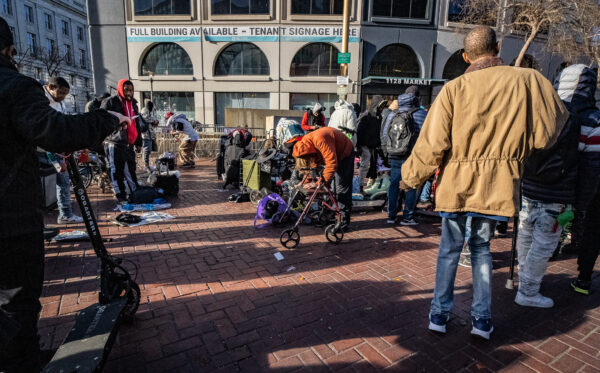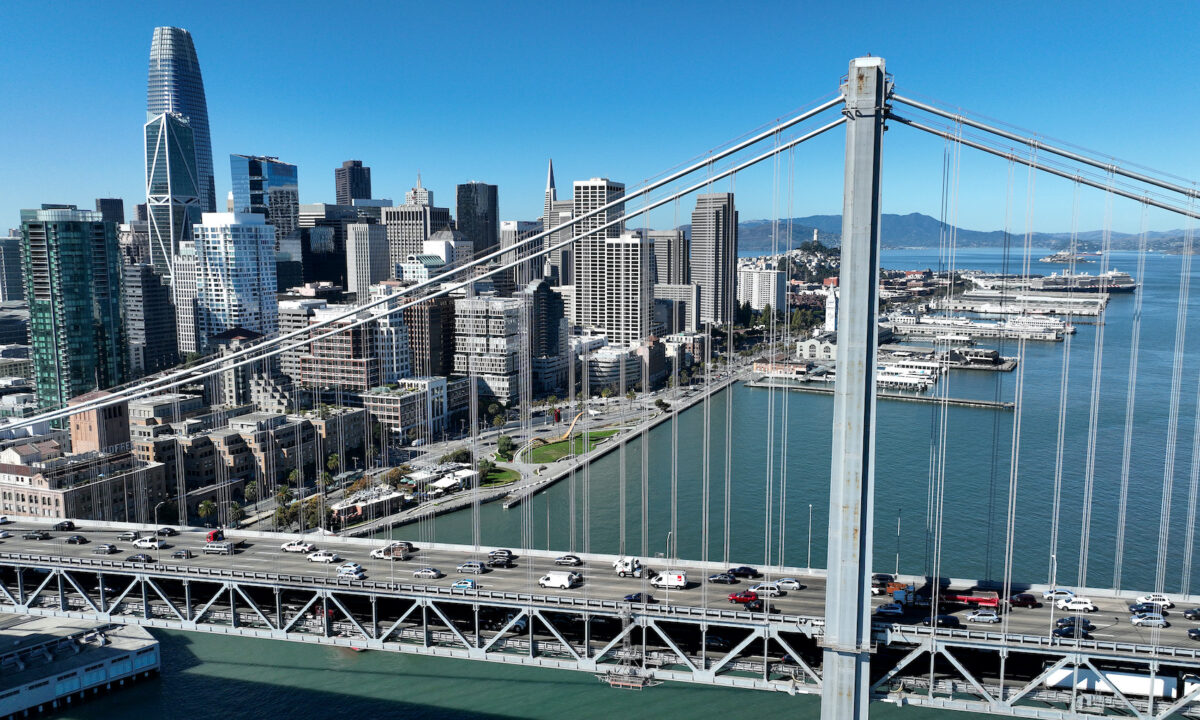Office vacancy rates in San Francisco continue to climb, with new records being set monthly as businesses continue to flee and office workers resist a return to the city, according to experts.
Vacancy rates reportedly surpassed 31 percent in May, the highest ever recorded in the city—historically known as an attractive location for businesses, ranking as one of the most expensive commercial real estate markets in the world.
Statistics vary based on source, but several brokers told The Epoch Times that the rate is higher than reported in San Francisco.
“The vacancy is really upwards of close to 40 percent,” Hans Hansson, president of Starboard CRE—a commercial real estate firm located in San Francisco—told The Epoch Times. “The collapse is only beginning, and it’s going to get far worse. There’s going to be a lot of pain.”
Work-from-home routines that accelerated during the pandemic are to blame for a significant decline in office space demand, and tech layoffs have hit the city hard, with Meta—the owner of Facebook and Instagram among others—and Salesforce accounting for millions of square feet sitting empty, according to experts.

“We’re dealing with the element of hybrid work, and employees have not come back to the office,” Hansson said. “There was never a sense of urgency to get people back to work.”
Crime, open drug use, and homelessness are contributing to the problem, according to experts familiar with the area.
“The amount of theft that’s occurring has blindsided our city,” Hansson said. “Between defunding the police and the belief by some here that the homeless should be allowed to shop and steal, it’s just unbelievable.”
Policies pertaining to public safety are to blame for the state of the city, and a lack of contrary opinions is exacerbating the problem, Hansson added.
“We’re a one-party town, and there’s no opposition voice, and as a result of that the city is really run by non-profits,” Hansson said. “The independent voices that could help turn this city around are just not here. The business community is pushed aside, and we have a weak Chamber of Commerce.”
Compounding Problems Impacting Downtown
Sustained vacancy rates and increased incidents of crime are taking a toll on the downtown area, and commercial real estate brokers are reporting defaults and severely discounted properties.
In a sign of the times, the Union Bank tower at 350 California Street has reportedly been sold for a 75 percent discount, with the sale price of just more than $60 million a mere fraction of the original listing price of $250 million. The building was valued at more than $300 million before the pandemic but currently has less than 25 percent occupancy, as reported by the Business Times.
Brokers say the price could set a benchmark for future valuations, as California Street has always ranked as one of the most expensive locations in the world for office space, and with the deal not yet closed, some are suggesting the selling price could go lower before the deal is finalized.
With prices falling and vacancy rates soaring, experts say the predicament is a tale of winners and losers, with opportunities for brokers, buyers, and tenants while landlords and banks are taking the losses.
Cash buyers are reportedly securing aggressive deals, and brokers reported having their best quarter ever to start this year thanks to the ability to offer attractive deals to clients, with some proposals coming in at half the price per square foot of current leases.
While the headlines and statistics are gloomy, several brokers told The Epoch Times they are cautiously optimistic.
“San Francisco is a cat of nine lives, and we’ve reinvented ourselves repeatedly over the years,” Hansson said. “It’s a great place to live, the natural beauty is there, but our leadership is not there.”
Office and Retail Market Vacancies Creating Opportunities
Experts familiar with the retail sector say its health is tied to that of office space, and the outlook is mixed.
“It’s been a wild ride, but we’re seeing a lot of recovery,” Cameron Baird, senior vice president for retail sales and leasing in San Francisco at Avison Young, a global real estate advisory firm. “The headlines capture all the bad news, but not all the good news.”
Baird noted that while the pandemic and inflation have created additional challenges, there are significant opportunities for retail tenants.
“It was difficult for a client to get in before the pandemic because we had less than 3 percent vacancy downtown,” Baird said. “Now we’re seeing very advantageous rental terms. There is no better time to go shopping for retail in Union Square and downtown than now.”
While acknowledging that crime and homelessness are impacting the area, experts say that foot traffic downtown is picking up, and people are out and about during lunchtime and after work.
But they say, the absence of office workers drastically impacted businesses in the area, and with vacancy rates continuing to climb, the short-term future for downtown is uncertain.
“It’s going to get a little worse before it gets better, but we’re seeing a lot of positive signs in the market,” Nick Slonek, principal and regional managing director at Avison Young, told The Epoch Times. “Companies are pursuing flights to quality,” in this sense, he said, by seeking out accommodations in newer buildings with bay views.
Office markets are described as distinctly separate, with top floors in trophy buildings in high demand, while lower floors and space in older structures with fewer amenities to offer are seeing declines.
With quality driving demand, some buildings are now being offered with amenities that rival luxury resorts in an effort to create a sense of community and make employees enjoy their time at work, according to experts.
“They can create the culture they need and bring people back to the office,” Slonek said. “It’s more of an experience, with soft seating, fireplaces, game rooms, places where you can get spa treatments.”
Some Suggest Making Office Space Affordable Housing
With the city facing a lack of housing and an abundance of empty office space, some have proposed repurposing commercial space into new housing units.
But significant barriers exist that could limit such, with cost and functionality being two primary obstacles, according to experts.
“In many instances, infrastructure costs would be more than ripping the building down and starting anew,” Slonek said. “Communal bathrooms don’t work in a condominium footprint.”
By building from scratch, it’s possible to build based on demand, with multi-purpose buildings using retail concepts on the bottom spaces, offices in the middle, and residential on the top floors, according to experts.
Lack of Financing Contributing to Dilemma
Adding to the issue is that banks have tightened lending on commercial real estate transactions, with brokers reporting a sharp increase in borrowing costs since the pandemic.
Multiple brokers told The Epoch Times that deals are now being done with an interest rate between 9 and 12 percent on average, with 50 percent down required, as compared to 2.5 percent interest and 10 to 20 percent down in 2019.
“There’s no money out there,” Slonek said.
Additionally, concerns exist that issues with commercial mortgage-backed securities could lead to broader financial market instability in a similar fashion that home mortgages facilitated the 2008 meltdown, according to experts.
But even amid tough local economic conditions and the high probability of a nationwide recession later this year, commercial real estate professionals in San Francisco remain confident that the city will rebound thanks to an abundance of natural beauty and thought leaders in the area.
“The amount of international intellectual capital drawn to the universities in the area will never stop,” Slonek told The Epoch Times. “It’s a great place to live.”
















































